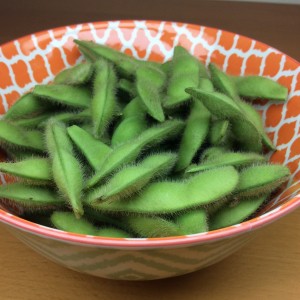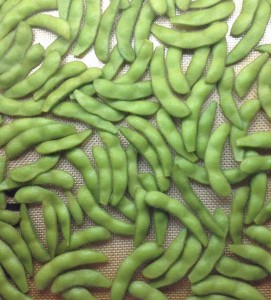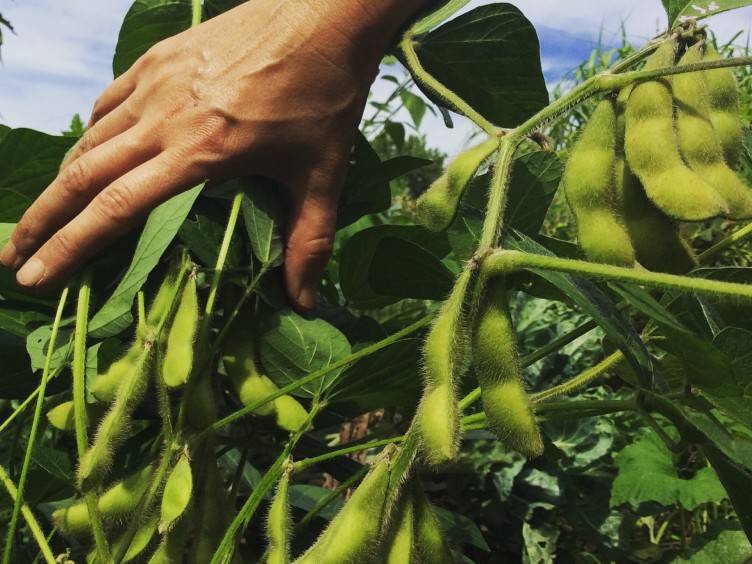I remember the first time I tried edamame. I was in a Japanese restaurant, and the server placed a bowl of warm little bean pods on our table. When I popped a bean into my mouth, my first thought was wow! My second thought was buttery! Followed quickly by what are these things? Ever since then, I’ve been hooked.
Edamame is an immature soy bean. That’s right, those small round white beans that are used to make the somewhat bland and rubbery tofu used to be delicious green shell beans when they were younger. They are great for snacking, can be added to stir fries or fried rice, or even used instead of chickpeas to make a hummus-like spread.
 It turns out that edamame is easy to grow in the backyard garden, too, and grow similarly to bush beans. Plant them once the soil has warmed and the risk of frost has passed, which is the end of May in my zone 6 garden. I have been planting the seeds about 4″ apart, but I noticed that the commercial farmers plant them much more densely, more like 1″ apart, so I will try closer spacing this year. Succession planting is a good idea to spread out the harvest – the pods on one plant are ready all at the same time, and will not produce more.
It turns out that edamame is easy to grow in the backyard garden, too, and grow similarly to bush beans. Plant them once the soil has warmed and the risk of frost has passed, which is the end of May in my zone 6 garden. I have been planting the seeds about 4″ apart, but I noticed that the commercial farmers plant them much more densely, more like 1″ apart, so I will try closer spacing this year. Succession planting is a good idea to spread out the harvest – the pods on one plant are ready all at the same time, and will not produce more.
Once they start growing, they are low maintenance, and will reach a height of about 2 or 3 feet. The flowers are insignificant. One plant will produce a surprisingly large number of pods.
Figuring out when to pick the fuzzy pods is a bit tricky. In general, pick them when they are bright green and plump. When they start to turn yellow, you know you have waited too long – at this point the beans will taste rather starchy, and you might just want to leave them for seed.
Saving seeds is easy, just wait for the pods to dry completely on the plant, then take them out of the shell and store in a cool, dry place. If you have trouble with insects, you can put the seeds in the freezer for a few days to kill off any critters. For me, the seeds do not remain viable very long, two years at most, so make sure to save seeds every year or every other year.
 To cook the edamame, boil them in salted water for about 5 minutes. The pods should be easy to split and the beans will pop right out. If you have too many to use right away, you can store them in the fridge for about a week, or blanch them by boiling them for 3 minutes, immersing in ice cold water for 6 minutes, then freezing them on a cookie sheet.
To cook the edamame, boil them in salted water for about 5 minutes. The pods should be easy to split and the beans will pop right out. If you have too many to use right away, you can store them in the fridge for about a week, or blanch them by boiling them for 3 minutes, immersing in ice cold water for 6 minutes, then freezing them on a cookie sheet.
With all the advantages of edamame there is one more: it is good for the soil. If you pull up one of the finished plants, you will see fairly large pinkish nodules attached to the roots. These are filled with beneficial soil bacteria that will help all your other plants grow. So when I harvest the edamame, instead of pulling up all the roots, I cut off the stems at the soil level, and let the roots decompose in place, to keep the bacteria in the soil.
When you are planning your garden for this summer, make some space for edamame. You’ll be in for a tasty treat!
Edamame (soybean, Glycine max)
sowing style: direct seed, succession planting
timing: start planting 1 to 2 weeks after frost-free date
requirements: full sun, well drained soil
spacing: 3 to 4 inches
height: 3 feet (no support needed)

